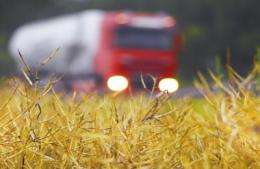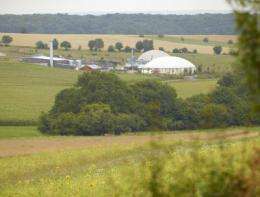There is biofuel production from rapeseed oil. Credit: André Künzelmann/UFZ
An interdisciplinary team of 11 scientists from seven European countries and the USA have discussed the concept to utilize so called surplus land for the production of feedstock for bioenergy. They identified environmental, economic and social constraints but also options for efficient use of surplus land for bioenergy. The study provides a scientific background in support of a reassessment of land available for bioenergy feedstock production. Their findings were published in the open access journal BioRisk.
Increasing demand for bioenergy feedstock is generating land-use conflicts which are currently discussed in the food vs. fuel controversy and the debate about indirect land-use change. Concepts for solving those conflicts suggest a spatial segregation of food/feed and bioenergy producing areas. It is suggested to continue producing food/feed on established agricultural land while growing dedicated energy crops on so called "surplus" land.
Confusion in the applicability of those concepts is however caused by ambiguity in the definition and characterization of surplus land as well as by uncertainties in assessments of land availability, both on the national and the global scale, and of the potential yields of bioenergy crops when grown on surplus land.
This is a bioenergy plant in Jühnde with CHP. Credit: André Künzelmann/UFZ
'We still have limited understanding of how much land is truly surplus and suitable for energy crop production' said Dr Dauber, the lead author of the study, 'because constraints arising from environmental and socio-economic implications of bioenergy development in those areas are often not accounted for in assessments of land availability'.
The authors suggest a thorough reassessment of land availability for bioenergy production by clarifying the terminology of surplus land and taking both constraints and options for efficient and sustainable bioenergy-land use into account. Policy recommendations for resolving conflicting land-use demands are provided.
In Dr Daubers opinion, 'factoring in the constraints, combined with creativity in utilizing the options provided by the novel cropping systems, would lead to a more sustainable and efficient development of the bioenergy sector'.
More information: Dauber J, Brown C, Fernando AL, Finnan J, Krasuska E, Ponitka J, Styles D, Thrän D, Van Groenigen KJ, Weih M, Zah R (2012): Bioenergy from "surplus" land: environmental and socio-economic implications. BioRisk 7: 5-50. doi: 10.3897/biorisk.7.3036
Provided by Helmholtz Association of German Research Centres



















